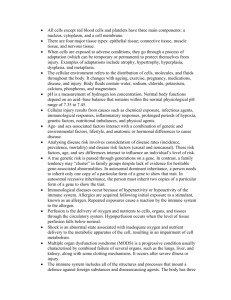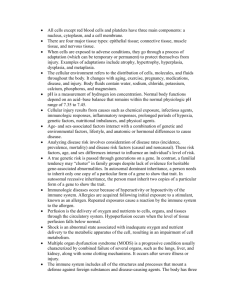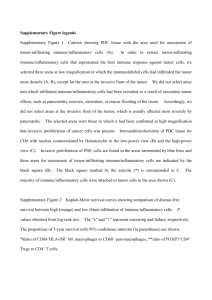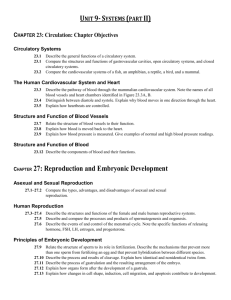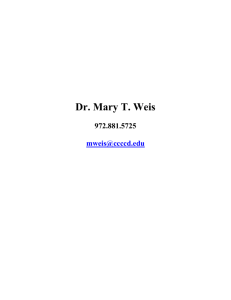Chapter 8: Pathophysiology
advertisement
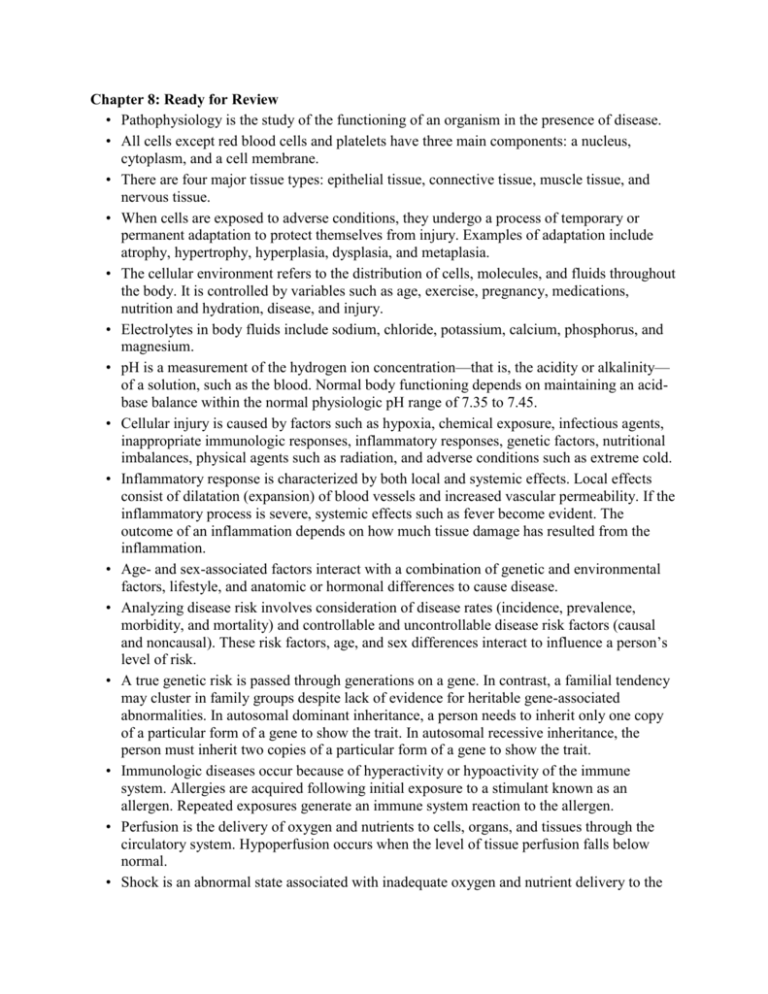
Chapter 8: Ready for Review • Pathophysiology is the study of the functioning of an organism in the presence of disease. • All cells except red blood cells and platelets have three main components: a nucleus, cytoplasm, and a cell membrane. • There are four major tissue types: epithelial tissue, connective tissue, muscle tissue, and nervous tissue. • When cells are exposed to adverse conditions, they undergo a process of temporary or permanent adaptation to protect themselves from injury. Examples of adaptation include atrophy, hypertrophy, hyperplasia, dysplasia, and metaplasia. • The cellular environment refers to the distribution of cells, molecules, and fluids throughout the body. It is controlled by variables such as age, exercise, pregnancy, medications, nutrition and hydration, disease, and injury. • Electrolytes in body fluids include sodium, chloride, potassium, calcium, phosphorus, and magnesium. • pH is a measurement of the hydrogen ion concentration—that is, the acidity or alkalinity— of a solution, such as the blood. Normal body functioning depends on maintaining an acidbase balance within the normal physiologic pH range of 7.35 to 7.45. • Cellular injury is caused by factors such as hypoxia, chemical exposure, infectious agents, inappropriate immunologic responses, inflammatory responses, genetic factors, nutritional imbalances, physical agents such as radiation, and adverse conditions such as extreme cold. • Inflammatory response is characterized by both local and systemic effects. Local effects consist of dilatation (expansion) of blood vessels and increased vascular permeability. If the inflammatory process is severe, systemic effects such as fever become evident. The outcome of an inflammation depends on how much tissue damage has resulted from the inflammation. • Age- and sex-associated factors interact with a combination of genetic and environmental factors, lifestyle, and anatomic or hormonal differences to cause disease. • Analyzing disease risk involves consideration of disease rates (incidence, prevalence, morbidity, and mortality) and controllable and uncontrollable disease risk factors (causal and noncausal). These risk factors, age, and sex differences interact to influence a person’s level of risk. • A true genetic risk is passed through generations on a gene. In contrast, a familial tendency may cluster in family groups despite lack of evidence for heritable gene-associated abnormalities. In autosomal dominant inheritance, a person needs to inherit only one copy of a particular form of a gene to show the trait. In autosomal recessive inheritance, the person must inherit two copies of a particular form of a gene to show the trait. • Immunologic diseases occur because of hyperactivity or hypoactivity of the immune system. Allergies are acquired following initial exposure to a stimulant known as an allergen. Repeated exposures generate an immune system reaction to the allergen. • Perfusion is the delivery of oxygen and nutrients to cells, organs, and tissues through the circulatory system. Hypoperfusion occurs when the level of tissue perfusion falls below normal. • Shock is an abnormal state associated with inadequate oxygen and nutrient delivery to the • • • • • • • • • • • • • • • • • • metabolic apparatus of the cell, resulting in an impairment of cellular metabolism. Central shock consists of cardiogenic shock and obstructive shock. Cardiogenic shock occurs when the heart cannot circulate enough blood to maintain adequate peripheral oxygen delivery. Obstructive shock occurs when blood flow within the heart or great vessels (aorta and pulmonary vein) becomes blocked. Peripheral shock includes hypovolemic shock and distributive shock. In hypovolemic shock, the circulating blood volume is insufficient to deliver adequate oxygen and nutrients to the body. Distributive shock occurs when there is widespread dilation of the resistance vessels (small arterioles), the capacitance vessels (small venules), or both. Multiple organ dysfunction syndrome (MODS) occurs in acutely ill patients and is characterized by the dysfunction of two or more organs that were not affected by the physiologic insult for which the patient was initially being treated. Six organ systems are surveyed to determine whether a patient has MODS and, if so, how high a risk of mortality he or she faces: respiratory, hepatic, renal, hematologic, neurologic, and cardiovascular. The immune system includes all of the structures and processes that mount a defense against foreign substances and disease-causing agents. The body has three lines of defense: anatomic barriers, the inflammatory response, and the immune response. The two anatomic components of the immune system are the lymphoid tissues and the cells responsible for mounting an immune response. The primary cells of the immune system are the white blood cells, or leukocytes. There are two general types of immune response: native and acquired. Immunity may be humoral or cell-mediated. Important white blood cells in the immune system include neutrophils, eosinophils, basophils, monocytes, and lymphocytes. Other important cells of the immune system include macrophages, mast cells, plasma cells, B cells, and T cells. The antibodies secreted by B cells are called immunoglobulins. Antibodies make antigens more visible to the immune system in three ways: by acting as opsonins, by making antigens clump, and by inactivating bacterial toxins. The inflammatory response is the reaction of the body’s tissues to cellular injury. It is characterized by pain, swelling, redness, and heat. The two most common causes of inflammation are infection and injury. The plasma protein systems that modulate the inflammatory process include the complement system, the coagulation (clotting) system, and the kinin system. Cytokines are products of cells that affect the functioning of other cells; they include interleukins, lymphokines, and interferon. Chronic inflammatory responses are usually caused by an unsuccessful acute inflammatory response after the invasion of a foreign body, a persistent infection, or an antigen. Normal wound healing involves four steps: repair of damaged tissue, removal of inflammatory debris, restoration of tissues to a normal state, and regeneration of cells. Wounds may heal by primary or secondary intention. Healing by primary intention occurs in clean wounds with opposed margins. Wounds that heal by secondary intention have a prolonged inflammatory phase and more abundant granulation tissue. • Hypersensitivity is an increased response of the body to any substance to which the person is abnormally sensitive. A hypersensitivity reaction may be immediate, occurring within seconds to minutes, or delayed, occurring hours to days after exposure to the antigen. • Hypersensitivity reactions may be classified as autoimmune, idiopathic, or blood incompatibility reactions. • Immunodeficiency may be congenital or acquired. • Stress does not cause death directly, but it can permit diseases to flourish, ultimately leading to death. • The general adaptation syndrome describes the body’s short-term and long-term reactions to stress. • Stress causes the sympathetic nervous system to be stimulated. This occurs through release of catecholamines that activate the sympathetic nervous system by binding to alpha and beta receptor sites, resulting in effects categorized as fight-or-flight response. • Stress also causes secretion of cortisol, which has many useful effects such as increasing serum glucose levels, decreasing protein reserves, and permitting mobilization of fatty acids. However, continuous secretion of cortisol has deleterious effects.
